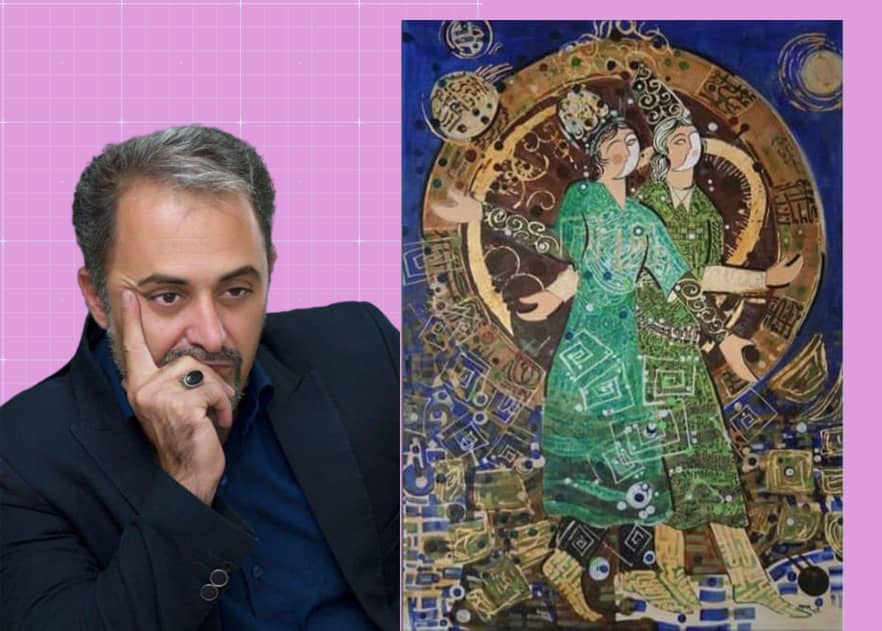
Mehrdad Fallah and the Work Sama Dance from the “Neo-Saqqakhaneh” Series: A Journey Between Yesterday and Today
The painting Sama Dance is not merely a depiction of motion—it is, in itself, a movement from form to meaning. With a contemporary gaze rooted in Iranian cultural heritage, Mehrdad Fallah has created a piece in which history, mysticism, and art converge—precisely where Iranian art once again orbits around the axis of light.
ArtDayMe : We take a closer look at "Sama Dance", a painting by Mehrdad Fallah—an artist known for his innovative approach to traditional Iranian painting. Created in 2019, this work belongs to the Neo-Saqqakhaneh series and was rendered in mixed media on canvas, measuring 80 × 114 cm.
“Dance in the Spiral of Light and Mystery” could easily serve as a compelling journalistic title for Sama Dance. Yet beyond the name, the work holds a significant place within Fallah's conceptual universe as a revitalization of ancient Iranian traditions through a modern lens.

Within the realm of contemporary Iranian painting, there are artists who boldly revisit tradition—not as a relic of the past, but as a living, interpretable text. In Sama Dance, from the Neo-Saqqakhaneh collection, Fallah endeavors to translate the elevated concepts of Eastern mysticism into a contemporary and multilayered visual language rooted in traditional Iranian arts.
This piece is a visual reflection of the mystical Sama ritual—a Sufi dance wherein the practitioner, through continuous whirling, transcends the self to unite with a higher truth. At the heart of the composition, a male and female figure are shown mid-dance, seemingly spinning around a luminous center within a golden circular orbit.
This circle is more than form—it is meaning itself: a symbol of unity, eternity, and the singular divine presence around which existence revolves.
The Neo-Saqqakhaneh style is powerfully present here: a fusion of figurative elements with geometric motifs, abstract calligraphy, and decorative signs drawn from Islamic-Iranian art. Through traditional motifs—such as repeating squares, mysterious circles, and structures reminiscent of ancient stucco carvings—Fallah constructs a visual realm where the viewer’s perception continuously oscillates between past and present, matter and meaning.
The color palette has been deliberately chosen to serve the narrative. Shades of blue and green evoke calm, spirituality, and a connection with nature, while the golden background recalls divine light and sacredness. The simultaneous presence of earthy tones at the bottom of the canvas and luminous hues at the top lends a vertical structure to the painting—signifying an ascent from the terrestrial to the celestial, from multiplicity to unity.
The use of mixed media and varied textures lends a tangible depth to the canvas, suggesting that each physical layer represents a conceptual one. The viewer is not simply witnessing a depiction of dance, but rather, encountering a visual interpretation of a spiritual journey. In this work, Fallah elevates ornamental language beyond mere aesthetics, transforming it into a vessel for philosophical expression.
Sama Dance is not only an image of motion—it is a movement itself, bridging form and meaning. With a modern approach to Iranian cultural roots, Mehrdad Fallah creates a work where history, mysticism, and art unite—and in this union, Iranian art once again finds its axis in light.

Mehrdad Fallah’s Presence in Four Major Art Auctions
Born in Tehran in 1975, Mehrdad Fallah was raised in a traditional family—but it was no ordinary home. It was also the birthplace of one of the key pioneers of contemporary Iranian painting: the late Sadegh Tabrizi, Fallah’s uncle and mentor, under whom he became a dedicated and distinguished student.
Fallah’s works have appeared in four notable art auctions, each time exceeding initial estimates: the 21st Tehran Auction in October 2024 (selling at 187 million tomans), the Second National Auction in 2015, the Goharan Auction, and a charity auction in Los Angeles.
His art has been exhibited across countries including the UK, Switzerland, Italy, Belarus, Cyprus, Turkey, the United States (Los Angeles), Dubai—and of course, Iran. Interestingly, his entrance into the art world dates back to 1998 at the age of 23, with a window exhibition at Gallery 66, an influential space founded by Sadegh Tabrizi himself.
Since then, Fallah has held six solo exhibitions, the most prominent of which was Lion in Script at Art Center Gallery in 2015, widely recognized for its cultural impact.
Over the years, Fallah has developed a unique signature by blending painting with Iranian symbolism. He is known for drawing on the traditions of Iranian art to create modern and contemporary works. His acclaimed series—Lions, Roosters, and the intriguing Wonders of Creation—have brought him widespread recognition.
Many art critics regard Mehrdad Fallah as a leading figure in the revival and continuation of the Saqqakhaneh School in contemporary times.

LEAVE A RELPY